Intending to forage the new spring tips of the local spruce here in Ontario, I visited a grove of Norway Spruce (Picea abies) in a nearby park in early May. The Norway Spruce, along with the native White Spruce (Picea glauca) are the most common spruce trees in the southern Kawarthas of Ontario; both are great for wild food. The spruce tree is a needled evergreen conifer tree that ranges in mature height from only a few feet to over a hundred. Their edibility (from cones to leaves, bark, pollen and sap or gum), while relatively unknown to our settler cultures, is a staple to indigenous peoples across Canada—particularly for its Vitamin C content. Spruce trees also provide foraging opportunity all year round. The needles are edible and most commonly used to make a hot tea, which is steeped (not boiled) to retain its nutritional quality.
All parts of the tree are non-toxic. Medicinal and nutritional qualities of the spruce include help with the respiratory system; active vitamin C, which fights against colds and infections; Spruce needles contain large amounts of shikimic acid, which is a flu-fighting compound and helps fight respiratory ailments. They also contain antioxidants.
The spring shoots of spruce trees are lime green, soft and flexible. If you nibble on one, high in Vitamin C, it will taste a little like ‘pine’ with a citrus finish, making it a great mouthwash. The young shoots, which stand out from the darker mature needles from last year break off easily from the branch for effortless harvest. Not all spruce tips taste the same. The Forager Chef recommends White Spruce, Blue Spruce, and Norway Spruce.
“Spruce tips have a fantastic shelf life.” Alan Bergo of the Forager Chef tells us. “Picked fresh and cooled immediately, they can last for multiple months in the cooler under refrigeration at a restaurant. Home refrigerators dry foods out faster than commercial refrigeration units, so you want to be extra careful to keep them in a damp environment.” He adds, “I like to store them in a plastic bag with a couple holes punched in it for them to breathe, along with a damp paper towel or two to help hold in moisture. If you’ll be keeping the tips for a month or longer, make sure to change the towel every week or so. Spruce tips can also be frozen, and used for my ice cream and syrup recipe.”
In my upcoming eco-novel, Thalweg, one of my characters is a young Gwich’in scientist who returns to the Arctic in search of her destiny with water. Bobby-Jo recalls when she was first introduced to chewing spruce gum by her older brother, Johnny:
“I thought of when I was five years old, when older brother Johnny introduced me to sticky gum, dzih drinh’. He showed me how to harvest raw dzih ant’at, the hardened amber resin that forms from the pitch oozing out of a scar on a black spruce. Johnny was always chewing it; it took me a while to develop a liking for the ‘sprucy’ bitter paste.”
Nina Munteanu, Thalweg
How To Identify a Spruce Tree
Any spruce tree can be distinguished from two other common and similar looking conifers, the fir (Abies spp.) and the pine (Pinus spp.), by several features. Pines have fascicles that bunch up collections of two or five usually fairly long and slim needles. The spruce needle has no fascicles, but attaches to the branch through a tiny leaf stalk; this is unlike the fir, whose needle is directly attached to the branch. Spruce needles are four-sided and end in a sharp point. Fir needles are quite flat and do not end in a sharp point. Close inspection of their needles reveals a series of white dots on the spruce needle and two white lines on the underside of the flatter fir needle. Spruce needles also attach all around the branch, whereas the fir is often attached in a flat arrangement.
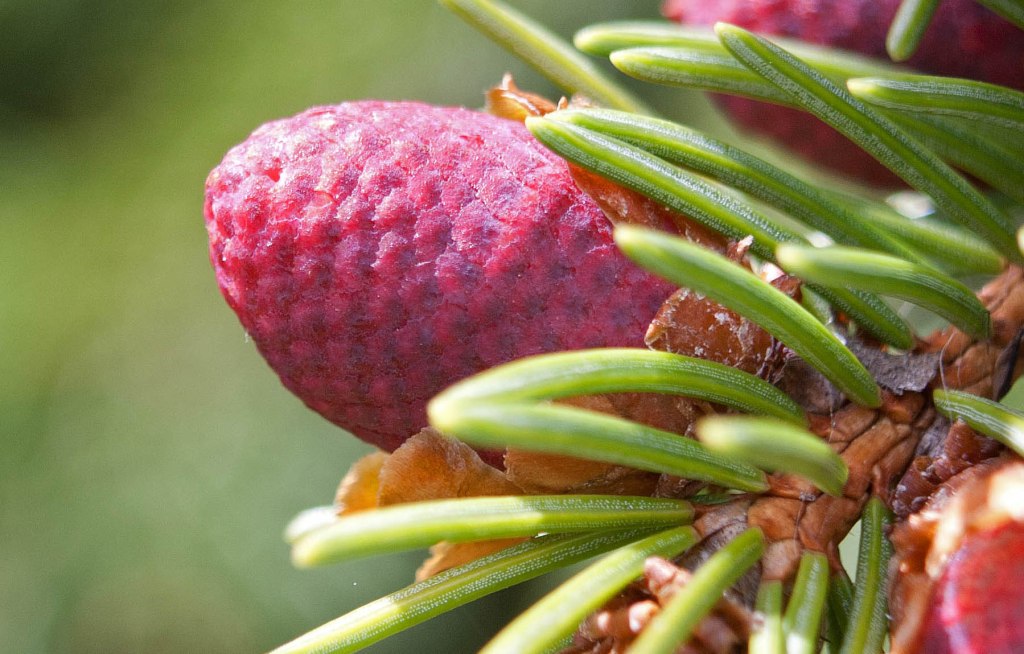
Eat the Planet warns that “The highly toxic Yew (Taxus baccata) plant could potentially look like a spruce to the untrained eye and grows side by side in many environments, but in reality it is quite different and is not commonly mistaken for a spruce. These are some of the features of the yew plant that can distinguish it from spruce: Needles are flat and bendable with a dark top and a lighter colored bottom side, no cones present (yews produce red fruit with a single seed), needles grow primarily laterally from the stem (concentrated on the sides of the stem, not top or bottom), mature height of a yew is around 20′ but usually they are less than 10′, overall shape of tree/shrub may or may not be conical naturally and is sometimes pruned into a conical shape. The yew is a common landscape shrub, so ask around and see if you can find one then learn its features. Make sure you are 100% positive that you are not foraging from a yew thinking it is a spruce.”
Edible Immature Male Spruce Cones
When I got to my grove of spruce trees, I realized that I was too early for the spring shoots. The bright green soft growths hadn’t emerged yet. But the immature male and female flowers (cones) were out in full force. The magenta-pink immature male cones dangled on the draping spruce branches like strings of grapes on a vine. Shaped like a tiny American football and delicately scalloped, these cones eventually swell with pollen and the gentlest breeze—or a probing finger releases a cloud of yellow into the air. Some foragers harvest the male cones at this stage for their pollen, which they use for various things in meals. Blanche Cybele Derby’s YouTube video provides several interesting uses for spruce cones and tips.
The unfertilized female cones of the Norway Spruce are larger than the males, elongated and a deep magenta colour, and found on the tips of the branches. The female cones contain ovules, which develop into egg cells when fertilized by the male gametophyes (pollen) brought to them by the breeze—or a probing finger!
An embryo is produced in the female cone, protected by a seed coating. The process of ripening takes about three years, after which the female cone opens and releases its seeds.
I picked a small bag’s worth of the immature male cones from several lower branches of several trees. Once home, I introduced these cones for brunch on freshly made waffles, along with blueberries and maple syrup. The cones added a wonderful texture and nutty-citrus flavour to the sweet dish. I then added them to a mixed green salad for an additional subtle forest taste and texture.

Avoid over-harvesting. Don’t collect too many tips or cones from any branch or single tree. These are the tree’s new growths and it needs them to survive.
Alan Bergo, the Forager Chef offers good advice on this:
- pick from elder, mature trees; young trees need time to grow
- never pick more than 20% of the tips from a single tree
- never pick tips from the apical meristem, or top of a young tree, which would stunt it’s growth (I defer to point #1 on this)
Haphazard Homestead offers additional advice. She advises a focus on the lower branches and interior of the tree where the new growth that will be shaded and die back anyway. Think of it as pruning the tree as once you pick off the new growth, the tree will not grow back there.
How to Make Hot or Cold Spruce Tea Using New Shoot Needles or Older Needles
Haphazard Homestead shares that the taste of spruce tea is distinct over each season. A winter spruce tea made from mature needles has a strong flavour; tea made with spring spruce tips is lighter and milder. Nibbling on the newly-grown fresh tips reveals a strong taste of ‘pine’ resin and citrus. Haphazard Homestead warns that if you aren’t a fan of strong coffee, dark chocolate or highly hot beer, the flavours may be too strong.” The tea carries less of the resinous astringent taste and more of a citrus bouquet.
Healthy Green Savvy describes their spruce tea as “just like a Christmas tree smells. That scent that gets in your nose as you decorate your tree is exactly what you taste when you drink spruce tea. Really delightful and uplifting.”
Cold Tea with Spruce Tips
“When the tips are soaked in water or other liquids, the resinous flavour steps back and more of the citrus flavour comes forward. Once that spruce flavour sits for a couple of hours…it’s like drinking the forest,” says Haphazard Homesteader. When I made my cold spruce tip tea (by simply steeping them in cold water overnight), I found the subtle floral flavour delightfully surprising. It was slightly citrus with a hint of floral perfume.
Hot Tea with Spruce Tips or Mature Needles
- 1-2 tbsp spruce needles, on or off the branch, rinsed
- 1 cup freshly boiled water
- honey (optional)
There is no need to pull off the needles from the branch. Simply dunk the branch with needles (mature or new tips) into the pot or cup of boiled water and let steep, covered, for at least fifteen minutes. The longer you steep, the stronger the flavour and more of the useful compounds from the needles will infuse the tea. I add a little honey, but if you prefer a clean fresh taste of spruce, add nothing else.
Making my Spruce Tip Tea
I returned to my Norway Spruce grove a week later and found young spruce shoots emerging out of their small protective ‘caps.’ Bright, almost fluorescent lime green, the young needles were soft and pliable. They were the size of the tip of my small finger and when I nibbled one, it tasted citrusy and slightly woody.
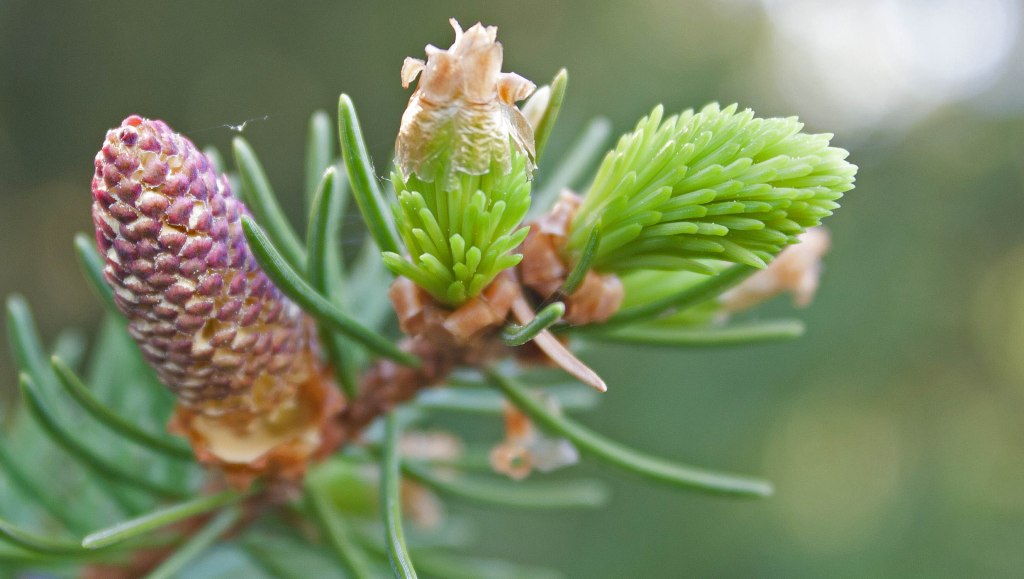
I pinched off several dozen young tips and brought home a small bag-full from which we made a tea by simply adding boiled water to the spruce tips and letting them steep for fifteen minutes, covered. The tea poured clear and friend Merridy’s first impression on tasting the tea was: “tastes like a spring day.” Then she had another sip and amended thoughtfully, “like the first floral essence of spring.”
I agreed. I more inhaled the taste of the spruce tea. It was so delicate and smooth, with subtle notes of citrus and something elusive, like a forgotten memory from a spring day.
The second cup, after ten more minutes of steeping, released more complex and stronger aromas and notes of wood, along with some acidity. Merridy shared that, “you can almost taste the grain of the wood. Like the memory of the tree’s intention.”
Making Spruce Tip Syrup
Forager Chef describes this easy and wonderful way to use spruce tips: “This is a cousin of Italian mugolio (pine cone syrup) and it is one of the easiest, most delicious ways to capture the flavor of your favorite tree. It takes at least a month to make (I’ve seen older recipes where they instruct you to bury a jar of spruce tips and sugar in the ground) but the finished product is so worth it.”
Here’s Forager Chef’s simple recipe:
“You take equal parts spruce tips and sugar–no weight measurements, no finicky scales, and mix them together, put them in a jar, let them sit in the sun for a couple months, then heat, strain, and voila–syrup that tastes like the soul of a spruce tree.”
The real secret here is the type of sugar you use. Forager Chef insists on brown sugar: “The secret is all about harnessing aromas [and] giving aromas a place to go. Aromas like spruce are very water soluble. The magic happens when the natural moisture from the spruce tips seeps into the sugar, making a watery slurry which can absorb aromas better than a thick mat of sugar. Brown or organic sugar are what you want here for two reasons: 1, the color of the finished syrup is more attractive. 2. Brown sugar contains more moisture than white, and more moisture, means a more aromatic syrup. Makes sense, right?”
Right!
I’ll be doing this with my harvested spruce tips. I’ll let you know in a month or so how mine turns out.

Nina Munteanu is a Canadian ecologist / limnologist and novelist. She is co-editor of Europa SF and currently teaches writing courses at George Brown College and the University of Toronto. Visit www.ninamunteanu.ca for the latest on her books. Nina’s bilingual “La natura dell’acqua / The Way of Water” was published by Mincione Edizioni in Rome. Her non-fiction book “Water Is…” by Pixl Press(Vancouver) was selected by Margaret Atwood in the New York Times‘Year in Reading’ and was chosen as the 2017 Summer Read by Water Canada. Her novel “A Diary in the Age of Water” was released by Inanna Publications (Toronto) in June 2020.

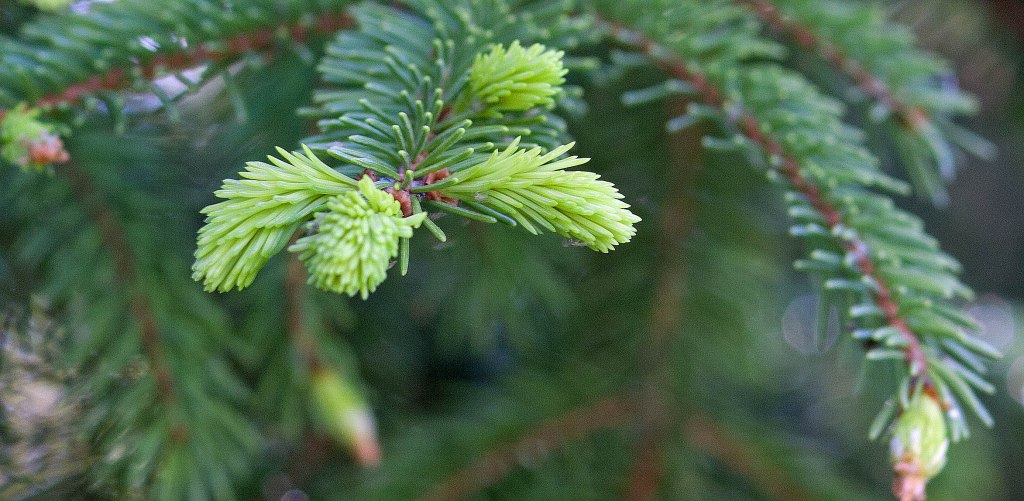
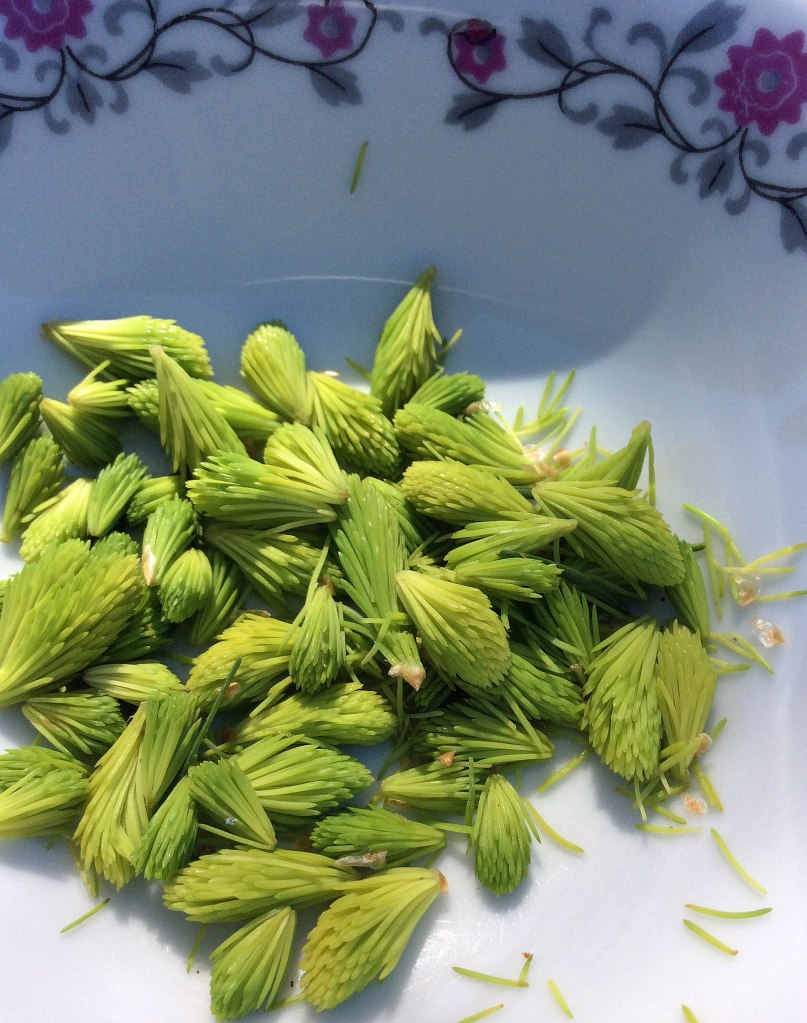


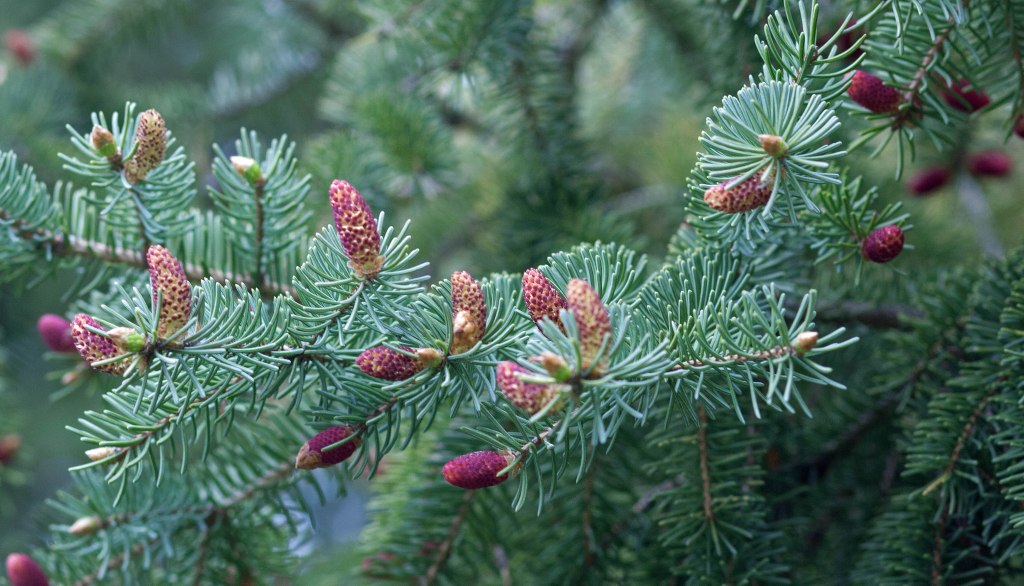


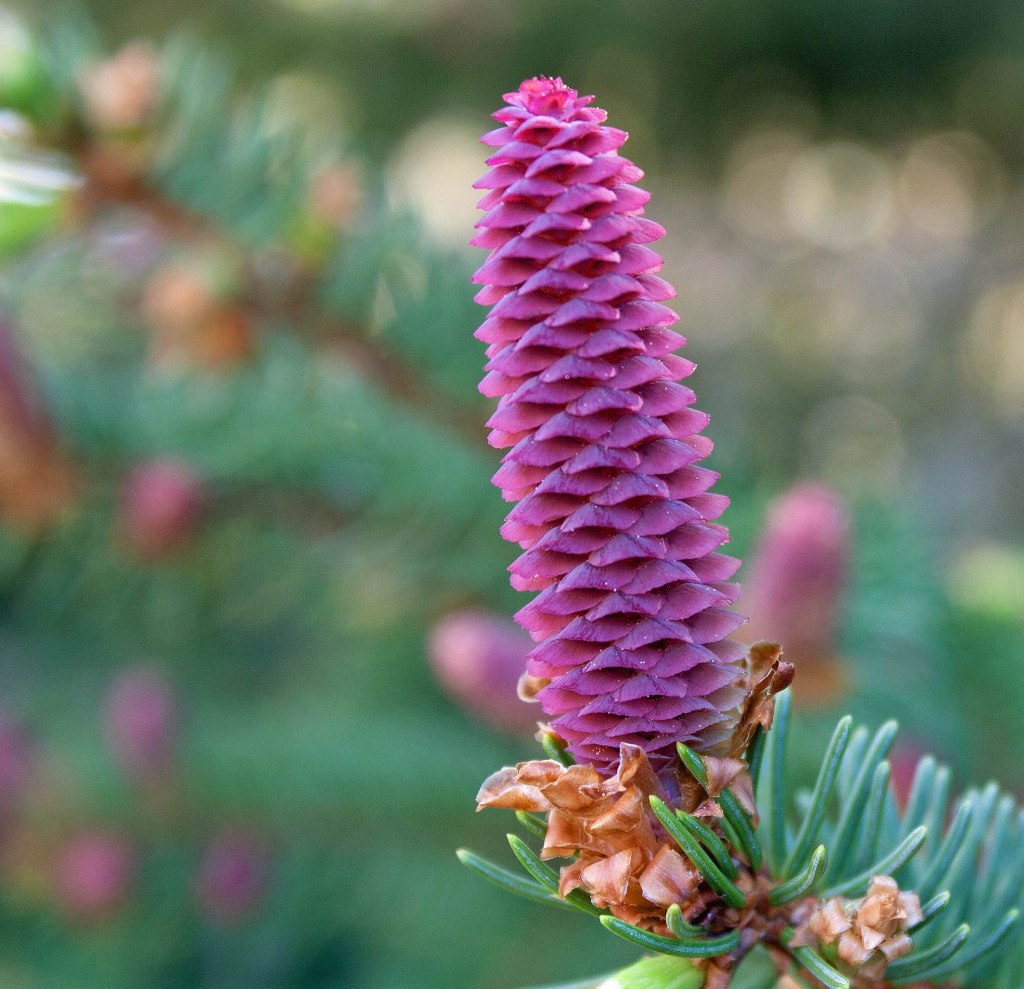

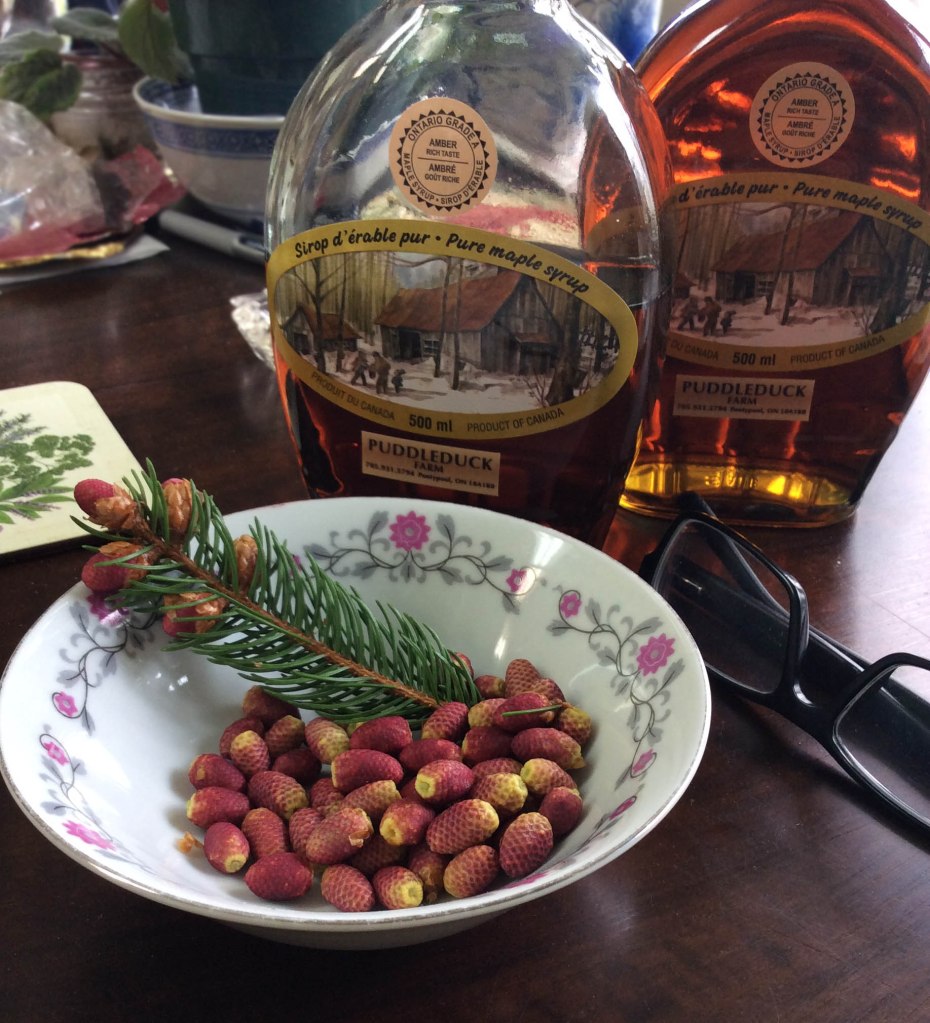




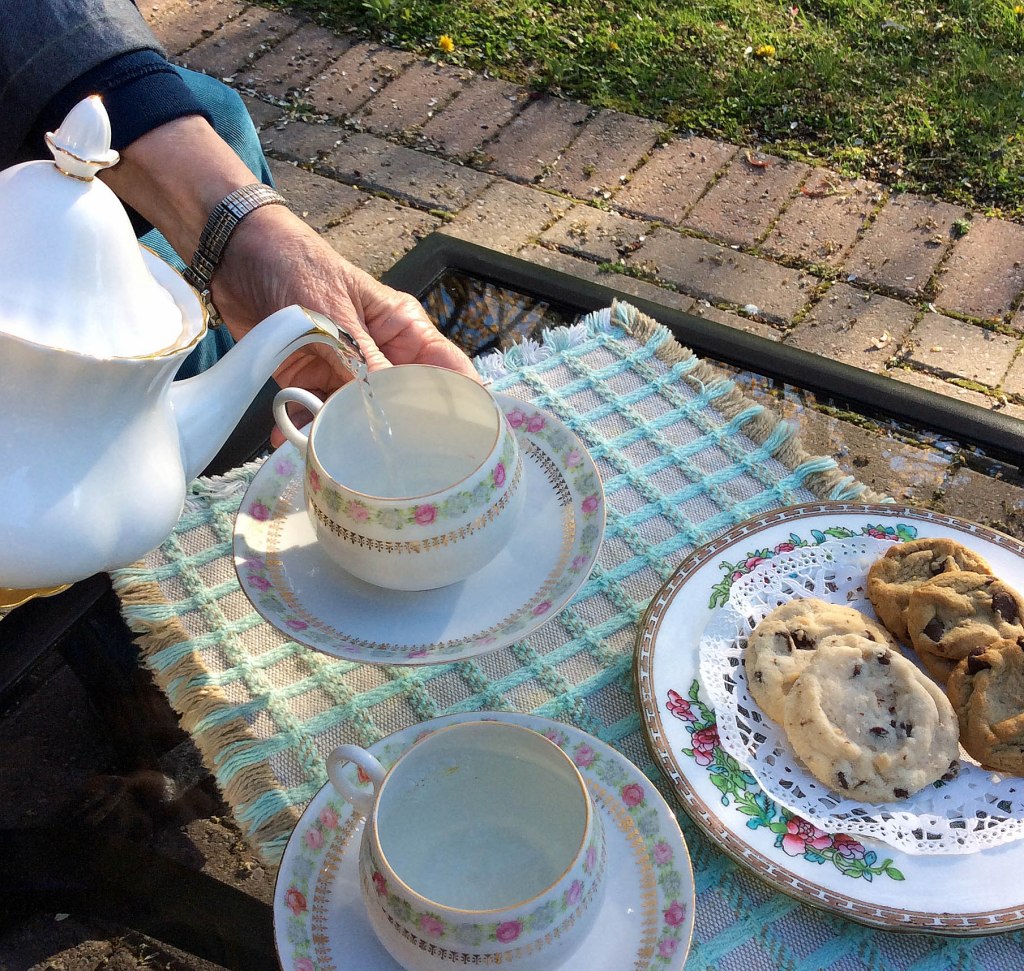

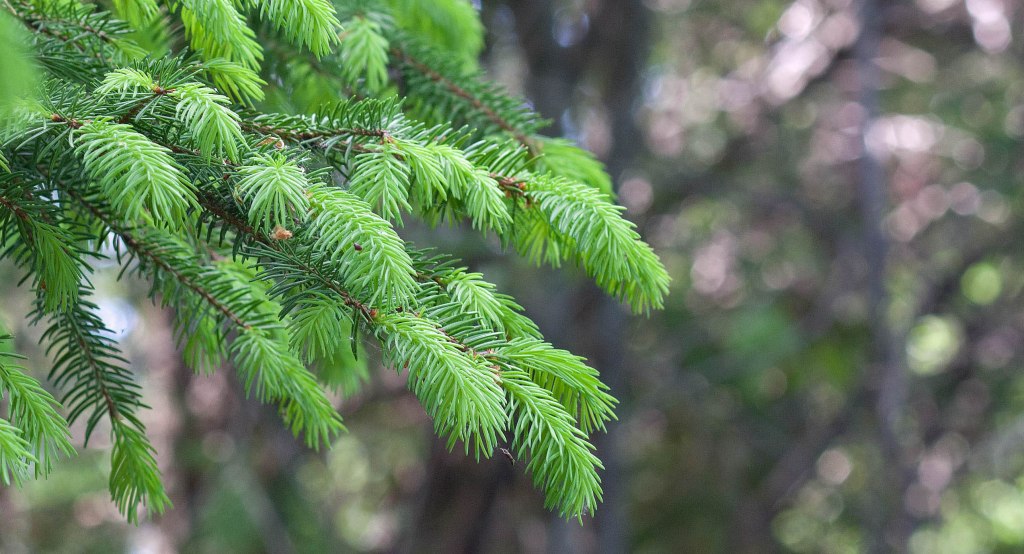
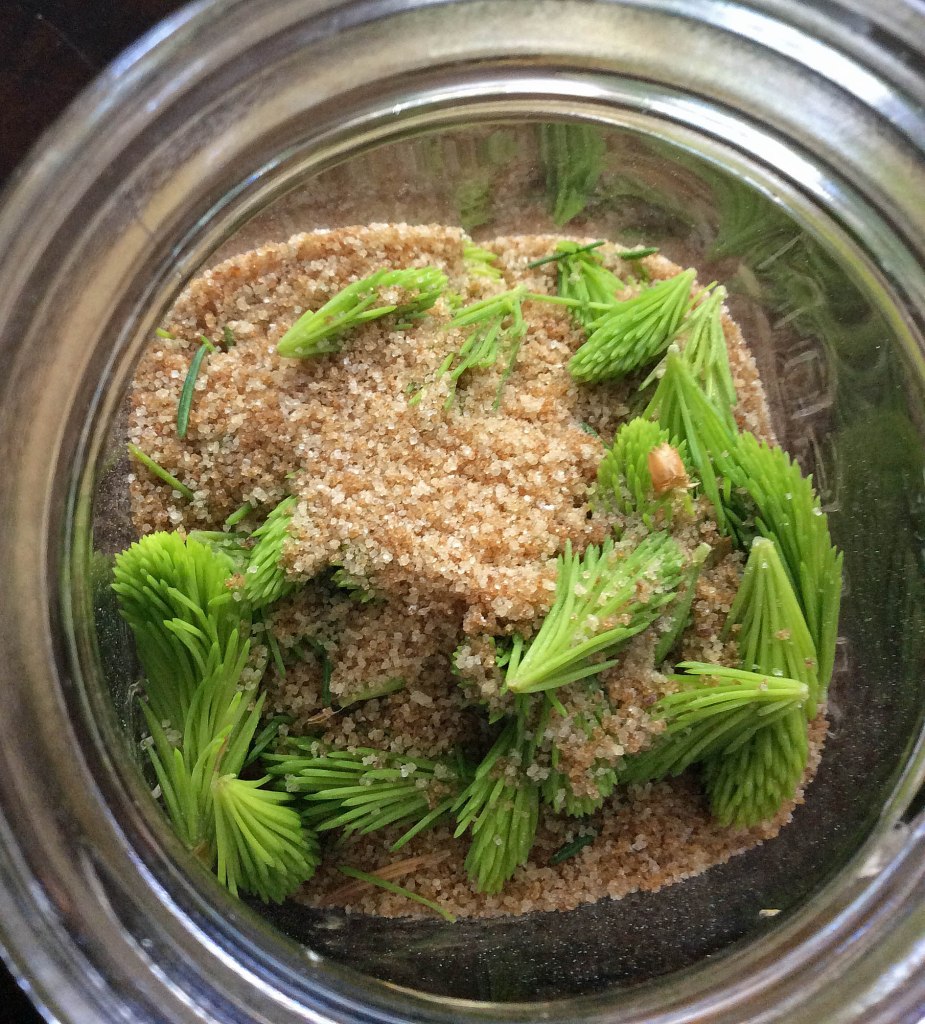
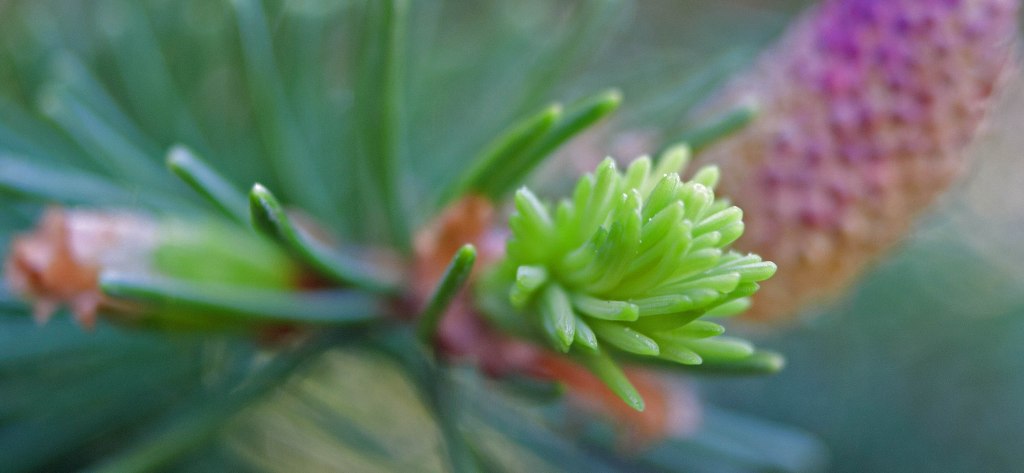
p.s. Facebook friend Jennifer Kennedy noted that “We have made spruce beer a few times. It was a common drink around here back in fur trade days, as spruce, like hops, adds both flavour and preservative qualities.” This reminded me that my son makes craft beer and he sometimes uses spruce needles to add a wonderful citrus note to his Saison artisanal beer. And it’s AWESOME! Nina
LikeLike
We have few spruce trees in our yard. I never seen red cones in anyone of them since last 12 years. This year all of them are loaded with red cones. I’m surprised that how this could be possible? Hope it’s normally okay.
LikeLiked by 1 person
That’s interesting… It may just have needed to reach a certain maturity to make the male and female cones. 🙂 Have fun with them. Aren’t they beautiful?
LikeLike
Trees, including spruce, can have a mast year where they produce an abundance of cones. It was probably a mast event that you observed. It’s quite the interesting phenomenon.
LikeLike
Trees, including spruce, can have a mast year where they produce an abundance of cones. It was probably a mast event that you observed! It’s quite the interesting phenomenon.
LikeLike
Yes, very likely, Shannon. And luckily I was there to take photos. 🙂 Enjoy!
Best, Nina
LikeLike
What a great article and pictures. I am teaching my grandson about conifers, and this info came just in time. Thank you. I wonder how long it takes for a male cone to grow from bud to maturity.
LikeLiked by 1 person
Hi Margareta,
According to Purdue, it takes the male cone two years to fully mature. Cool! All the best, Nina
LikeLike